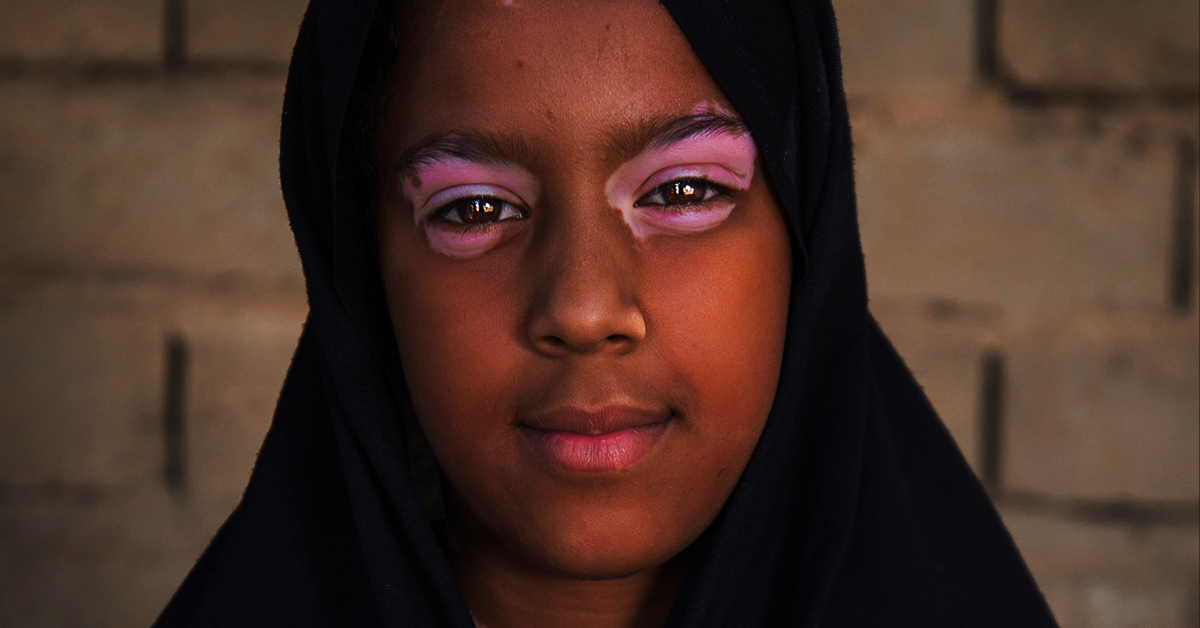
by DEBATRI DATTA, MD; RASHMI SARKAR, MD, MNAMS; and INDRASHIS PODDER, MD, DNB
Dr. Datta is a consultant dermatologist at Oliva Skin Clinic, in Kolkata, West Bengal, India. Dr. Sarkar is with the Department of Dermatology, LHMC and associated KSCH and SSK Hospital in New Delhi, India. Dr. Podder is with the Department of Dermatology, College of Medicine and Sagore Dutta Hospital in Kolkata, West Bengal, India.
Vitiligo, urticaria, and acne vulgaris, can 1 J Clin Aesthet Dermatol. 2021;14(9 Suppl 1):S19–S23 Chronic childhood dermatoses, such as atopic dermatitis, psoriasis, ichthyosis, require frequent dermatologic consultations and have a profound impact on a pediatric patient’s quality of life. Demand for social and psychological support increases as these children grow up and integrate into society, and children with severe disease may need around-the-clock care for years. Studies have shown that parents caring for children with chronic disorders often experience negative changes in psychosocial status, which can negatively impact adherence to treatment for the child, resulting in worsening of the condition.1–3
Although research exists for chronic systemic illnesses, such as epilepsy, asthma, cancer, and diabetes, to our knowledge, literature is scarce regarding the eff ect that caring for a child with a chronic dermatosis can have on the parent.2 Here we explore the existing literature to better understand the impact that caring for a child with a chronic dermatosis can have on the parent/caregiver’s mental health (e.g., stress) and quality of life.
MATERIALS AND METHODS
We undertook a comprehensive English literature search across multiple databases including PubMed (MEDLINE database), Scopus, and Cochrane using the keywords (alone and in combination) and MeSH items “chronic childhood dermatoses” OR “atopic dermatitis” OR “vitiligo” OR “psoriasis” OR “acne” OR “urticaria,” AND “parental stress” OR
“caregiver stress” OR “parent quality of life” OR “caregiver quality of life” OR “family quality of life” to obtain relevant articles, priority being given to prospective, randomized, controlled trials and those concerning chronic dermatological disorders and parental or caregiver stress. Additional data were obtained from the reference lists of selected articles.
RESULTS
Overall we obtained three review articles (1 foused on atopic dermatitis) and 20 clinical studies (5: atopic dermatitis, 4: vitiligo, 4: psoriasis, 1: psoriasis and atopic dermatitis, 1: epidermolysis bullosa, 5: chronic childhood dermatoses, 1: alopecia areata). We analyzed these articles and prepared the current manuscript along with a relevant review of literature.
DISCUSSION
Although there have been several studies concerning parental stress in chronic childhood morbidities, such as bronchial asthma, cancer, epilepsy, juvenile rheumatoid arthritis, and sickle cell anaemia,2 data specifi ally on chronic dermatoses are scarce. Among the available relevant literature, the majority of
FUNDING: No funding was provided for the preparation of this article.
DISCLOSURES: The authors have no confl icts of interest relevant to the content of this article.
CORRESPONDENCE: Indrashis Podder, MD, DNBD; Email: ipodder88@gmail.com
| TABLE 1. Potential causes of increased stress in parents/caregivers of children with chronic skin diseases | |
| IMPORTANT REASONS OF INCREASED PARENTAL STRESS | POSSIBLE EXPLANATION |
| Child’s behaviour | • Affected children suffering for a long time may become clingy and needy.
• Psychiatric disorders such as depression and anxiety may develop. • Severe disease may cause more behavioural problems. |
| Parent-child relationship | • Parents may become stressed by their child’s need for constant attention.
• Social isolation of the child (possibly into adolescence) may affect the parents. |
| Psychosocial functioning of parents | • Parents/caregivers can suff er from worry, emotional lability, depression, anxiety, and embarrassment.
• Parents/caregivers can feel guilt, shame, and anxiety over the consequences faced by children. • Parents/caregivers may be overprotective of their children and/or give in to their children’s demands due to emotional exhaustion. |
| Marital relationships | • Marital discord may arise due to unnecessary self- or partner-blaming for familial diseases.
• Partners may develop feelings of jealousy over lack of intimate time.7 |
| Sleep disturbance in parents | • Nocturnal caring of children can disturb sleep pattern of caregivers. |
| Diet and meal preparation | • Adjustments, if any, required for the children’s diet can cause stress. |
| Environmental factors | • Adjustments in home environment, like changing and washing sheets regularly or cleaning up after the sick child, can cause stress. |
| Financial burden | • Regular cost of medicines, multiple doctor visits, transport, etc. can eat into the family budget.
• Time contributed to patient care can aff ect employment of the caregiver. |
| Sibling problems | • Yet unstudied–attention given to sick children can stress siblings and cause familial discord. |
with atopic dermatitis were more anxious and depressed, compared to controls.22 However, educational interventions and behavioural modifi cations have been shown to reduce the severity of disease in the child and help both child and parent/caregiver improve psychologically.23
A study using the Infants’ Dermatitis Quality of Life Index (IDQOL) and Dermatitis Family Impact (DFI) to measure the quality of life in families with children with atopic dermatitis noted tiredness and sleep deprivation in parents/caregivers due to the children taking a long time to fall asleep.24 In a study by Sarkar et al,25 researchers reported increased stress and submissive personality traits in mothers of Indian children with atopic dermatitis, which appeared to increase psychological disturbances in their children. In addition to emotional stress, the need for cleanliness to avoid environmental allergens, as well as the imposed fi nancial burden as a result of long-term treatment and care, were reported to further increase stress in parents and caregivers of such children.25
| articles we found pertained to childhood atopic dermatitis, followed by psoriasis.1–3 Our analysis of the available data revealed that chronic childhood dermatoses can affect the parental/ caregiver’s quality of life and induce stress for several possible reasons, which are highlighted in
Table 1.4–10 Scales to assess parental/ caregiver stress. A vital problem in assessing parent/caregiver stress is the paucity of scales to document its presence and severity. Such documentation is necessary, not only for academic purposes but also to assess the role of therapy in such individuals. Over the years, several scales and instruments have been designed to measure the impact of dermatological diseases on families and caregivers (Table 2).7,11–20 |
Atopic dermatitis. Atopic dermatitis is one of the most studied childhood dermatoses in relation to familial stress. A study of American children with atopic dermatitis reported that parents experienced self-blame and guilt on observing their children suffer.5 As the disease persisted into adolescent years, resultant social isolation of the child often prolonged and aggravated parental stress.5 In a Chinese study,21 mothers spent more time with their children with atopic eczema, compared to other caregivers, and reported more suffering (i.e., negative effects on mental and physical well-being due to difficulty in simultaneously managing childcare responsibilities with other household responsibilities.5 Another study reported that mothers caring for children |
Vitiligo. Vitiligo is an acquired depigmenting disease that destroys melanocytes, aff ecting one or multiple regions of the body.26 Childhood vitiligo is common—50 percent of vitiligo patients note onset before 20 years of age, amd 25 percent have onset before the age of 10. There is female preponderance for vitiligo and segmental distribution (i.e., distributed along a dermatome).26 Though vitiligo does not cause physical limitations, the cosmetic disfigurement can result in social discrimination and ostracization of the child, which can negatively impact the psychosocial status of the child, the child’s parent/caregiver, and other members of the child’s family.
Studies in children and adolescents with vitiligo have assessed its impact on patient quality of life, and a greater incidence of childhood depression has been reported.27,28 Interestingly, the decreased quality of life appeared to be dependent on the patient’s apprehensions and psychosocial adjustments, rather than actual clinical severity.29 However, very few studies are available regarding the stress of parents, caregivers, and families in regard to their children with vitiligo.
A study by Amer et al included 50 children with vitiligo and their parents and 50 healthy
S20 The Journal of Clinical and Aesthetic Dermatology • September 2021 • Volume 14 • Number 9 • Supplement 1
controls.30 The Self-rated Health Measurement Scale (SRHMS) and the Dermatitis Family Impact Questionnaire (DFI) were used to assess the impact of vitiligo on the life of the patients and their families. Investigators reported greater psychological distress and feelings of embarrassment among parents of patients with vitiligo. Parents of children with generalized, progressive disease were more severely aff ected. The mothers were more aff ected than fathers, reporting exhaustion, self-blame, and disappointment regarding disease prognosis.30
A Brazilian study assessing anxiety and depression in caregivers of pediatric dermatology patients noted anxiety and depression in 42 percent and 26 percent of participants, respectively.31 The extent of visible body surface area affected correlated with degree of anxiety in caregivers. An Indian study noted parents of children with vitiligo reported being worried about the children developing low self-esteem and difficulty in arranging marriages for them.32 This parental anxiety was reported to conversely aff ect the children psychologically, in that the children became concerned over their parents distress. Another hospital-based Indian study on immediate caregivers (parents and grandparents) of pediatric patients with vitiligo, using the Family Dermatology Life Quality Index (FDLQI), detected emotional distress in caregivers and impaired quality of life in female patients and those with longer duration of disease. The researchers recommended psychiatric counseling for the patient and family members.33
| TABLE 2. Important scales that assess stress and quality of life in parents/caregivers of children with chronic dermatoses | ||
| SCALE | INFORMATION | DISEASE |
| Family Dermatology Life Quality Index (FDLQI)12 | Semi-structured interviews with family members | Any skin disease |
| Dermatitis Family Index (DFI)7 | Widespread, available in many languages | Atopic dermatitis |
| The Parents’ Index of Quality of Life in Atopic Dermatitis (PIQoLAD)13 | 28 items; change of 2–3 points is meaningful | Childhood atopic dermatitis |
| Measure of Quality of Life in Primary Caregivers of Children with Atopic Dermatitis (QPCAD)14 | Self-report questionnaire for past 1 week for caregivers | Childhood atopic dermatitis |
| Childhood Atopic Dermatitis Impact Scale (CADIS)15 | Eff ect on quality of life of children <6 years and families | Childhood atopic dermatitis |
| Psoriasis Family Index (PFI)16 | 14 questions to measure impact on quality of life of family members | Psoriasis |




